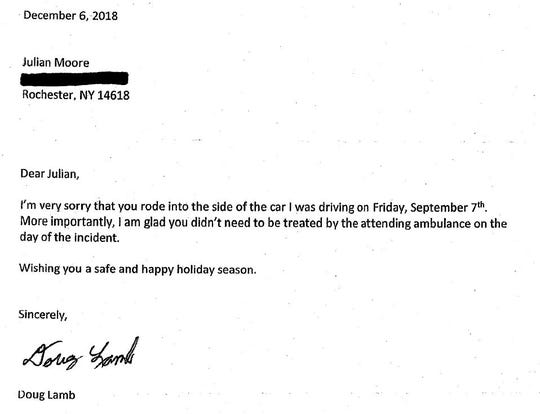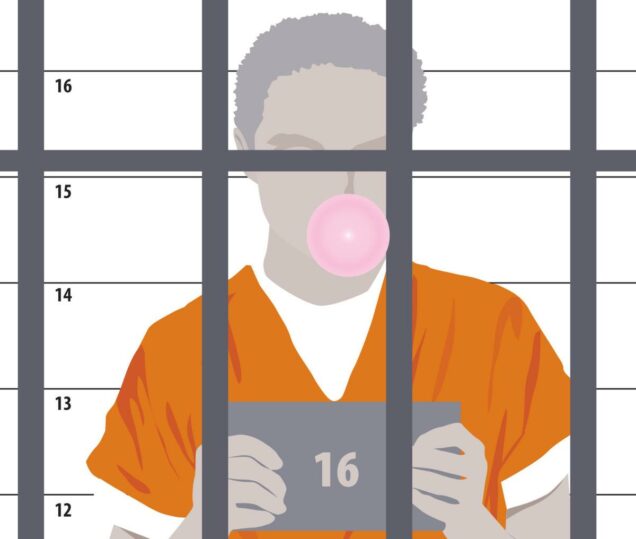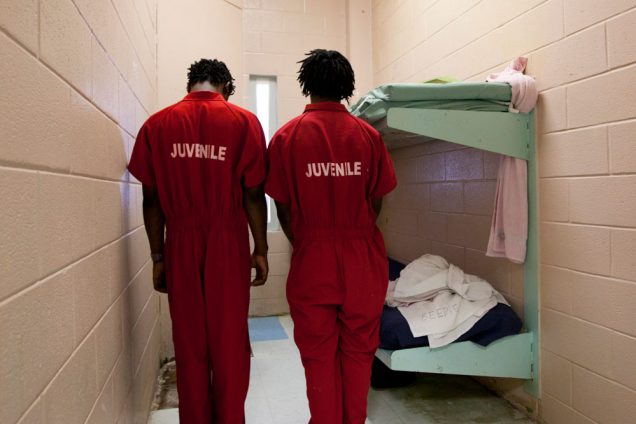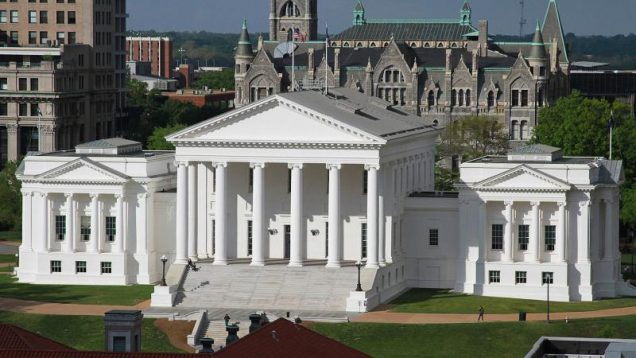Tagged: Boston University Law School
Supplying Housing Demand: Gov. Baker’s Proposed Housing Choices Act
There is no question that Massachusetts generally, and the Boston area in particular, is mired in an affordable housing crisis. Renters and would-be buyers are heavily burdened with disproportionate housing costs and are forced to compete for a limited supply of units. As of 2019, Massachusetts rental costs climbed to the third highest in the nation, surpassed only by California and Hawaii, making this the rare occasion in which beating New York isn’t something to celebrate. To increase housing, the state must address the burdensome rules that hinder the development of new units; especially multifamily homes. One possible solution is the proposed Housing Choices Act.
Though there are many facets to this issue and no simple solution, Gov. Charlie Baker is focusing on attacking the restrictive zoning rules and arduous permitting processes. Gov. Baker argues these rules are causing shortfalls in housing stock, driving up prices as demand far outstrips supply. Gov. Baker’s bill, the Housing Choices Act, was stalled throughout 2019, until late December when it was referred to the House committee of Ways and Means.
The Act has garnered the support of organizations such as the Boston Medical Center, Real Estate Bar Association, Massachusetts Municipal Association, Massachusetts Association of Community Development Corporations, Metro Housing Boston, and many more.
Gov. Baker’s administration has set a target of building 135,000 new housing units by 2025 and the Governor believes rezoning to allow more multifamily construction is a key piece in increasing housing production. Since 2017, Gov. Baker’s Housing Choices Initiative has incentivized municipalities to help meet this target by providing grants to support housing construction, but access to those grants still requires communities to vote in favor of rezoning. The Housing Choices Act would simplify rezoning by reducing the threshold of votes needed to pass certain kinds of progressive, production-oriented zoning changes in Massachusetts municipalities from two-thirds to a straight majority vote. Massachusetts is among the few states which require a supermajority for these kinds of zoning votes. The Governor calls the Housing Choice Act a “critical” piece of legislation in pursuit of production goals because it will ease that rezoning process.
Among the zoning changes to which the new straight majority vote would apply are the adoption of “smart-growth” districts under Ch. 40R, which governs…. “Smart growth” includes the construction of multi-family buildings, special permits for high-density construction, the reduction of size and parking requirements, transit-oriented projects with a set percentage of affordable units, and permission to construct accessory dwelling units.
Criticism: Too Narrow or Too Broad?
Critics such as Darnell Johnson, regional coordinator at Right to the City Boston, however, believe that the bill “ignore[es] the needs of working families” and will only lead to more luxury condos and other housing out of reach for most Massachusetts residents. Chris Norris, executive director Metro Housing Boston, concurs, and points out that with 250,000 low-income households forced to spend upwards of 50% of their income on rent, “incentives alone are not sufficient to product affordable housing.” Norris cites the fact that Ch. 40R was passed in 2004, was expected to generate 33,000 new units over ten years, and more than $20 million has been poured into its incentives. As of 2017, however, this law has produced only 3,500 units, less than half of which are designated as affordable.
Advocates within and without the Baker administration counter that this bill is not meant to be a panacea for housing woes but rather a step in the right direction. Clark Zeigler, executive director of the Massachusetts Housing Partnership, points out that right now good housing proposals are defeated despite winning majority support because of the current two-thirds voting requirements. Such was the case in Salem, where a measure to increase accessory dwelling units, one of the Housing Choice Act’s targets, won the majority, but not supermajority, and thus failed to pass. Salem Mayor Kim Driscoll supports Gov. Baker’s efforts to prevent situations like this, calling on local authorities to pursue a “strong partnership with state leaders.” Once this problem is solved, MHP and other affordable housing advocates can and will continue pushing for further means of providing relief to those overly burdened by housing costs. In an official statement, CHAPA (Citizens’ Housing and Planning Association) made its support of the Housing Choice Act clear for the same reasons. “Lowering the super majority threshold required for zoning changes will empower the simple majority of people in a community to vote ‘Yes’ for housing.” CHAPA sees the bill as an essential opportunity to help communities “encourage housing development and undo policies that prevent housing production and perpetuate segregation.”
Another source of criticism is a fear that the bill would inevitably cause unwanted and overly dense construction which will damage the character of older neighborhoods. Similarly, Rep. Smitty Pignatelli (D-4th Berk.) proposes that the switch to straight majority be predicated on local approval out of concern for state-level infringement on local autonomy. Sen. Brendan Crighton (D-Lynn), co-chairman of the Housing Committee, does not believe this is a real cause for concern, insisting that the bill “doesn’t take away any local control. . . [but rather] puts together a more common-sense approach that says a majority of folks can make a decision on the matter.” He sees this and similar legislation as crucial because Massachusetts’ housing production is half of what it was in the 1970s while rent has risen by 75% over the past twenty years.
Some communities, such as Needham and Springfield, believe they and some 70 other municipalities should be exempt from the bill because 10 percent or more of their housing stock already meets state “affordability” thresholds. Needham Select Board Chairman John Bulian sees requiring his town to comply would be penalizing it despite its having exceeded Massachusetts’ affordable housing percentage goals. Such complaints, however, seem to miss the larger picture of spurring more housing growth by enabling local residents greater control over their zoning through simplified zoning vote processes.
Massachusetts is in a housing crisis—one that can only be fixed by finding a way to build more housing. An important first step is to reform the rules and processes that restrict the needed housing units.
 Kellen Safreed anticipates graduating from Boston University School of Law in May 2021.
Kellen Safreed anticipates graduating from Boston University School of Law in May 2021.
Protecting Vulnerable Road Users: A Vicious Cycle
Ten-year-old, Julian Moore was riding his bicycle in a suburb in Rochester, NY on Sept. 7, 2018, when 66-year-old Doug Lamb hit him with his Range Rover.

Figure 1: Julian Moore and his mother, Jenny Moore, walk near the spot where Julian was hit while bicycling. (Photo: Max Schulte/Rochester Democrat and Chronicle).
Lamb stopped the car after his collision with Moore, but did not give his information to Julian, the paramedics, or Julian’s mother. By the time the police arrived, Lamb had departed the scene. It took two weeks for the police to track Lamb down and charge him with the misdemeanor crime of leaving the scene of an accident causing personal injury. Pittsford Town Judge John Bernacki had decided to adjourn the case in contemplation of dismissal, meaning Lamb’s record would be wiped clean, on the condition that Lamb write an apology to the boy.
His apology letter read:
This act of “contrition” drew sweeping public scorn in January after the boy’s mother, Jenny Moore, posted a copy of the letter on her Facebook Page and the backstory subsequently made headlines around the country. In response, prosecutors moved to re-open the case and proceed to trial for failing to meet the apology requirement of his plea deal.
Prosecutor Daniel Strollo said his office pursued the case to the extent that it did because Lamb neglected to meet the condition to which he agreed to resolve the matter. “Mr. Lamb was given one simple instruction: to send a letter of apology,” Strollo said. “He didn’t do that. When you don’t follow through on the terms of a commitment for a plea or a disposition of a case, our office is not going to just ignore it.”
Lamb plead guilty on Dec. 6 in Pittsford Town Court to leaving the scene of an accident causing property damage—a mere traffic infraction. In exchange, Lamb was ordered to pay a $200 fine, perform eight hours of community service.
Julian’s story garnered national attention for his crash. Lamb was protected by a 5,000-pound vehicle of steel. Julian was protected by a plastic helmet. If it seems ludicrous the legal system could enable Lamb to walk away with a small fine and apology, it may be time to even the playing field and shift legislative protections toward vulnerable road users such as Julian.
Vulnerable Road Users
All over the country, thousands of similar crashes are occurring in the shadows, without the benefit of a national audience holding drivers accountable. The National Highway Traffic Safety Administration data shows 857 cyclists were killed in crashes with vehicles the U.S. in 2018. The same study found Florida leading the country with 161 of those fatalities, finding bicycle deaths for those 20 and older have tripled since 1975.
However, Florida legislators are prepared to step up and do something about the mounting problem, formally adopting “Vision Zero Florida” with a strategic goal of zero traffic fatalities and severe injuries for all users. Part of this vision includes advocacy for a proposed bill, H.B. 455 – Traffic Offenses, in the Florida Legislature which provides criminal penalties for persons committing moving violations causing serious bodily injury or death to a vulnerable road user including: a fine, period of house arrest, mandatory driver education, revocation of driver license. One of the largest shifts however, is the establishment and definition of “vulnerable road user.”
The League of American Bicyclists, a national bicycle advocacy organization, defines a Vulnerable Road User (“VRU”) as “anyone who is on or alongside a roadway without the protective hard covering of a metal automobile. The term includes bicycle riders, pedestrians, motorcyclists, people in wheelchairs, police, first responders, roadway workers and other users like a person on a skateboard or scooter. It is meant to include people who are especially at risk of serious bodily harm if hit by a car, or truck.”
VRU laws operate on the principal of general deterrence - by providing an increased penalty for certain road behaviors that lead to the serious injury or death of certain road users people will be deterred from doing those behaviors around those users.
In 2007, Oregon became the first Legislature to pass, HB 3314, creating an enhanced penalty for careless driving if it contributes to serious physical injury or death to a “vulnerable user of a public way.” Currently, only nine 9 states have laws that define a vulnerable user or VRU and provide particular penalties for actions towards those vulnerable road users or when violations of traffic law lead to the serious injury or death of a VRU – Connecticut, Delaware, Florida, Hawaii, Maine, Oregon, Utah, Vermont, and Washington. In Texas, approximately 28 cities have passed their own VRU laws in the absence of a statewide version.
To advance this legislative effort, the League of American Bicyclists, proposes a model VRU statute for state legislatures. The model language: Section 1) defines VRU protected persons; Section 2) defines when the law is applicable and who can be charged with a violation of the law; Section 3) requires a person charged according to this law to attend a hearing; and Section 4) provides the punishments that are to be given to a person convicted of a violation of this law.
Road Ahead
Without enhanced protection for VRUs through increased penalties, it is common for a driver who kills or seriously injures a VRU to just be given a ticket for careless driving, as illustrated in a 2013 report by the Center for Investigative Reporting finding that in 238 pedestrian fatalities 60% of motorists found to be at fault or suspected of a crime faced no criminal charges.
As the closing lines of Prosecutor Strollo’s motion on behalf of Julian Moore states, “[t]he people are ready for trial.” Echoing a crystalizing national awareness that calls for increased protections to vulnerable road users, the people are ready for legislative change—and states legislatures should consider adopting a version of the VRU model law to meet this demand.
 Alexandra Trobe anticipates graduating from Boston University School of Law in May 2021.
Alexandra Trobe anticipates graduating from Boston University School of Law in May 2021.
The Fight for LGBTQ+ Justice and the Equality Act
Throughout American history, the LGBTQ+ community has continually faced unconscionable levels of harassment, discrimination, and vitriol; Congress cannot waste another session without passing the Equality Act into law.
Discrimination against the community is pervasive; LGBTQ+ Americans have reported harm to their mental health (69%), physical well-being and safety (45%), school environment (39%), work environment (53%), and relationships with their neighbors and local communities (57%). More than half of LGBTQ+ Americans have faced discrimination by healthcare providers. In surveys, LGBTQ+ Americans admit to using vague language about relationships (42%), refusing to talk about their partner (37%), hiding affiliations to LGBTQ+ groups (15%) and avoiding discussion of LGBTQ+ issues altogether (31%) out of fears of facing harassment and other damaging bigotry. Additionally, LGBTQ+ people have often changed the way they dress (15%), changed the way they talk (15%), cut important people out of their lives (16%), and moved away from their families (17%) because of the harmful consequences of discrimination.
Furthermore, transgender Americans face a disproportionate share of violence and discrimination – even compared to other members of the LGBTQ+ community. 33% of trans Americans have been denied equal services or physically attacked when visiting a place of public accommodation (like a hotel, restaurant, or government office). 27% of trans workers have been fired, not hired, or denied a promotion because of their gender. Additionally, 25% have been refused treatment or physically assaulted by their primary physician, health clinic, or hospital due to their gender identity – despite new Affordable Care Act regulations that were written with the specific intention to prohibit such discrimination against trans Americans by federally-funded providers. Members of the trans community have reported avoiding public transportation (11%), stores and restaurants (26%), and going to the doctor (24%) for fears of facing abuse and violence.
Queer people face high rates of discrimination and violence because of state and federal inaction. In twenty-nine states, LGBTQ+ Americans can be fired from a job, evicted from their home, or denied a line of credit because their employer, landlord, or bank disapproves of their sexual orientation or gender identity. In fourteen states, there is no ban on LGBTQ+ discrimination in schools. Clear and universal legal protections for LGBTQ+ Americans are desperately needed if our country is ever going to heal the evils that have been done for generations against our vulnerable population.
Therefore, Congress must pass a bold LGBTQ+ civil rights bill – such as the Equality Act sponsored by Representative David Cicilline (D-RI). This legislation would amend the Civil Rights Act of 1964 to protect Americans from discrimination based on “sex, sexual orientation, gender identity, or pregnancy, childbirth, or a related medical condition of an individual, as well as because of sex-based stereotypes” in federal funding, education, housing, employment, credit access, jury service, and public accommodations. It covers claims based on: (1) association with another member of a protected class; or (2) a perception or belief, even if inaccurate, that someone is a member of that class. The Act would expand “public accommodations” to include “any establishment that provides a good, service, program,…health care, accounting, or legal services,” or “any…transportation service.” Furthermore, the Act prohibits denying individuals access to a “shared facility” (restroom, locker room, dressing room, etc.) in accordance with their gender identity. Finally, the bill allows the Justice Department to bring these claims in federal court, and prohibits anyone who violates the Equality Act from asserting protection under the Religious Freedom Restoration Act of 1993 (RFRA) as a valid defense to discriminating against LGBTQ+ Americans.
 The Equality Act would be a crucial step forward for America. First, the bill expands protections under the Civil Rights Act of 1964 for all protected classes under the law, not just the LGBTQ+ community. For example, the bill would extend the Civil Rights Act’s current ban on discrimination based on sex to also cover public accommodations, state and local government services, and federal funding. Second, this bill would enact into federal law stronger anti-discrimination protections for the LGBTQ+ community than even the most liberal possible Supreme Court decisions could provide through Bostock v. Clayton County, Georgia (whether discrimination against an employee because of sexual orientation constitutes prohibited employment discrimination “because of . . . sex” within the meaning of Title VII of the Civil Rights Act of 1964, 42 U.S.C. § 2000e-2) or R.G. & G.R. Harris Funeral Homes Inc. (whether Title VII prohibits discrimination against transgender people based on (1) their transgender status or (2) sex stereotyping under Price Waterhouse v. Hopkins) this summer.
The Equality Act would be a crucial step forward for America. First, the bill expands protections under the Civil Rights Act of 1964 for all protected classes under the law, not just the LGBTQ+ community. For example, the bill would extend the Civil Rights Act’s current ban on discrimination based on sex to also cover public accommodations, state and local government services, and federal funding. Second, this bill would enact into federal law stronger anti-discrimination protections for the LGBTQ+ community than even the most liberal possible Supreme Court decisions could provide through Bostock v. Clayton County, Georgia (whether discrimination against an employee because of sexual orientation constitutes prohibited employment discrimination “because of . . . sex” within the meaning of Title VII of the Civil Rights Act of 1964, 42 U.S.C. § 2000e-2) or R.G. & G.R. Harris Funeral Homes Inc. (whether Title VII prohibits discrimination against transgender people based on (1) their transgender status or (2) sex stereotyping under Price Waterhouse v. Hopkins) this summer.
Finally, public opinion strongly supports passage of federal LGBTQ+ protections. 79% of Democrats, 56% of Republicans, and 70% of Independents polled in 2018 supported passage of non-discrimination laws to protect members of the LGBTQ+ community. This support includes a majority in every age group – from millennials to the elderly – and even includes a majority of white evangelical Protestants, a group that typically has conservative positions on social issues. Outside of polls, there are also a number of powerful interest groups supporting passage of the Equality Act. Such groups include civil rights organizations (ACLU, Anti-Defamation League, NAACP, AARP), women’s rights groups (NOW, CLUW), corporations (Visa, Mastercard, Apple, Google, Netflix, Microsoft, Amazon, eBay, IBM, Facebook, Airbnb, Twitter, Intel, American Airlines), medical and professional organizations (AMA, APA, ABA, National PTA), unions (CWA, SEIU, AFSCME, AFT), celebrities (Karamo Brown, Nyle DiMarco, Adam Rippon, Jesse Tyler Ferguson, Taylor Swift), and religious organizations (Episcopal Church, United Methodist Church, United Church of Christ, Evangelical Lutheran Church in America, More Light Presbyterians, United Synagogue of Conservative Judaism, Muslims for Progressive Values, Hindu American Foundation, Unitarian Universalist Association).
The Equality Act is certainly not perfect. An ideal bill would attack not just de jure LGBTQ+ discrimination, but also de facto discrimination caused by implicit biases and socioeconomic disparities. Such a law dedicated to establishing LGBTQ+ justice might: 1) specifically include HIV/AIDS status as a class of protected individuals covered by the Equality Act; 2) expand federal funding for Medicaid, public health clinics, mental health coverage, and combatting youth homelessness; 3) ensure all homeless shelters and rehabilitation centers receiving federal funds are LGBTQ+ affirming; 4) bolster protections against hate crimes, gun violence, and the targeting of LGBTQ+ populations by law enforcement; 5) require all private and public insurance plans to cover HIV prevention; 6) require school districts that receive federal funds to adopt sex education programs that are comprehensive and LGBTQ+ inclusive; 7) institute codes of conduct prohibiting bullying and harassment in our public schools; and 8) prohibit LGBTQ+ conversion therapy. However, under the current limitations of today’s Congress, the Equality Act seems a good first step towards building a broader movement for LGBTQ+ justice over the next decade.
Although polling shows that most Americans do not think “religious objections should be a reason to deny service to an LGBTQ person” in business (57%), healthcare (64%) or employment (62%), a recent Reuters poll found that only 23% of Americans know that federal LGBTQ+ protections haven’t been enacted yet. Given the high popularity of the Equality Act, and the even higher need for its invaluable protections, Congress must finally pass this vital civil rights bill into law. The lives of LGBTQ+ men, women, and children across the United States are at stake.
 Samuel Shepard graduated from Boston University School of Law in May 2020.
Samuel Shepard graduated from Boston University School of Law in May 2020.
Time to Hang up the Boxing Gloves? The Fight Over the Johnson Amendment
Most Americans have never heard of the Johnson Amendment, never mind the nearly 70 year legal and political battle over its meaning and reach. What is the Johnson Amendment, and why is it so important to so many organizations that they have been either trying to protect or destroy it for decades? This post will attempt to explain the long-fought political battle over the Johnson Amendment.
The Johnson Amendment prohibits not for profit, or 501(c)(3), organizations from participating in politics, including restricting them from endorsing political candidates. In 1954, then-Senator Lyndon B. Johnson sponsored the amendment to the tax code after two tax-exempt organizations opposed his candidacy in the recent Texas primary. Until then, tax-exempt organizations had been extremely engaged in political activity through the country. The Johnson Amendment was relatively successful in getting tax-exempt organizations from being politically engaged, at least directly. Many organizations, however, simply have separate political branches called 501(c)(4) political action branches. 
Recently, Amendment opponents, such as Congressman Steve Scalise (R-La.) and 40 other Republican Representatives, have introduced the Free Speech Fairness Act. This bill seeks to amend the Internal Revenue Code of 1986 “to allow charitable organizations to make statements relating to political campaigns if such statements are made in the ordinary course of carrying out its tax-exempt purpose.”—effectively repealing the Johnson Amendment. If passed, it will permit 501(c)(3) tax-exempt organizations under Section 501(c)(3) to endorse or oppose political candidates without fear of losing their tax-exempt status.
Supporters of the Johnson Amendment are varied, including both secular and religious organizations. The most outspoken supporter of the amendment is the Freedom From Religion Foundation (FFRF). The FFRF and other similar organizations fear repealing the Johnson Amendment would blur the traditional line between church and state. Other religious organizations, such as the Jewish Federations of North America, oppose the FSFA because they fear getting involved with politics would tarnish the integrity of their faith. Many of these organizations, particularly the FFRF, are especially concerned about the threat of “dark money” they fear repealing the Johnson Amendment would create. “Dark money” refers to political spending by nonprofit organizations that are not required to disclose their list of donors to the IRS or the public. This hidden list of donors can be problematic as many believe this allows nonprofit organizations to receive donations in exchange for political endorsements, influence in elections, and lobbying activities. Specifically, all 501(c)(3) nonprofits, except for churches and other religious organizations, must submit Form 990 to the IRS and demonstrate how they are spending their money and how much money they are receiving (though it does not require disclosure of who the donors are). Because churches do not need to submit this form, the Freedom From Religion Foundation and other opponents of the FSFA fear the bill could lead to churches becoming unregulated Political Action Committees.
Many conservative and religious organizations, on the other hand, support the FSFA. Its biggest proponents are religious organizations such as the National Religious Broadcasters (NRB), as well as conservative organizations like the Family Research Council (FRC). The Johnson Amendment has also garnered attention from President Trump, who has promised on many occasions to eliminate it due to its restrictions on free speech for priests, pastors, and other religious organizations. These groups, the sponsors of the FSFA, and the President argue the Johnson Amendment is unconstitutional because it stifles free speech, including the ability of religious figures and organizations to openly endorse or oppose individual political candidates from the pulpit. Some groups, like the Family Research Council, even argue the Amendment restricts the content of sermons as well, a claim made in an article titled “Figures of (Free) Speech,” published on February 4, 2019, which has since been taken off of the Family Research Council website.
However, is this argument an accurate representation of the law? Does the Johnson Amendment actually stop religious leaders from preaching on topics like “life or marriage” or of “conscience and convictions,” as the Family Research Council claims? The answer seems to be no. The Johnson Amendment does not restrict churches from discussing social or moral issues with their congregations, or even from lobbying Congress. The only restriction the Johnson Amendment imposes is specifically related to candidate endorsements and/or candidate opposition. Moreover, individual priests and pastors are actually free to endorse candidates when they do so as individuals, on their own, when they are clearly speaking as private citizens and not for their religious organization.
Beyond the organizations who are vehemently opposed to the FSFA, a LifeWay poll published in 2016 found that 79% of Americans do not believe it is appropriate for pastors to endorse political candidates during a public church service.
 This, therefore, begs the question, is the repeal of the Johnson Amendment really worth fighting for year after year? Not only do the constant attacks against the amendment cost pro-Johnson Amendment organizations like the FFRF money in time and labor expended through research and lawsuits, but it similarly costs opponents of the amendment valuable donation dollars that could be put towards something more meaningful or substantial.
This, therefore, begs the question, is the repeal of the Johnson Amendment really worth fighting for year after year? Not only do the constant attacks against the amendment cost pro-Johnson Amendment organizations like the FFRF money in time and labor expended through research and lawsuits, but it similarly costs opponents of the amendment valuable donation dollars that could be put towards something more meaningful or substantial.
In 2012, Pew Research published an independent guide to the IRS rules on political activity by religious organizations. The Pew Research guide “Preaching Politics From the Pulpit: 2012 Guide to IRS Rules on Political Activity by Religious Organizations” delineates specifically what religious organizations legally can and cannot do within the context of the Johnson Amendment. According to the guide, the political campaign intervention prohibition does not restrict the discussion of any issues desired, as long as they are not linked to supporting or opposing any specific candidates, PACs, or political parties. It therefore seems that the potential gains for the freedom of speech from this bill passing would be very little compared to the thousands of dollars wasted each year on both sides of the fight on this issue.
Finally, not only is the purpose of the bill not supported by the American public, but the concerns raised by opponents of the bill are especially troubling and should certainly make everyone question whether repealing the Johnson Amendment will ultimately do more harm than good. The separation of church and state is a foundational principle of our nation, and beyond the need to protect that balance, the concern organizations like FFRF have about the potential for dark money in religious institutions seems a valid concern, particularly because they do not submit Form 990.
Ultimately, lawmakers in Washington will need to decide whether it is worth continuing to introduce this bill every year and cost both sides of the argument time and money either trying to fight or support the repeal of the Johnson Amendment.
 Kate Lipman anticipates graduating from Boston University School of Law in May 2021.
Kate Lipman anticipates graduating from Boston University School of Law in May 2021.
The Comprehensive CREDIT Act: Taking Down Credit Barriers
A pivotal financial moment, like finding a new job, buying a home, or taking out a student loan, a person's credit history can become an obstacle to achieving what they want to do. Though credit reports and scores can be effective in determining whether to lend money to a borrower, they also tend to dictate where people can work or live. The Comprehensive Credit Reporting, Enhancement, Disclosure, Innovation, and Transparency Act (“Comprehensive CREDIT Act”) would change who could use a consumer’s credit information to make determinations and what impact, and for how long, other factors could have on one’s score. Congress should enact this bill. Not only is the Fair Credit Reporting Act (“FCRA”) outdated, but credit scores also tend to perpetuate discriminatory behaviors.
Credit Reports and Scores
A credit report provides a history of a consumer’s credit activity, including bill payments, current statuses of credit accounts, and adverse records like foreclosures, bankruptcies, and civil judgments. Credit reports also provide personal information like addresses, points of contact, and the consumer’s social security number. Three companies dominate the credit reporting industry: Equifax, Experian, and TransUnion. Though they never receive a consumer’s outright consent to compile personal data, these three private companies are the main credit report providers. If there are errors on the credit report, the consumer (1) must have access to a credit report or find out about the error another way; and (2) notify the credit reporting agency rather than the creditor that reported the error. Once the consumer has done this, the credit reporting agency’s duties are triggered.
A credit score is an assessment of how likely it is a consumer will fulfill a debt obligation on time. Several factors go into determining a credit score: payment history, current debts, the types and number of accounts one currently has, how long those accounts have been open, and issues like debt collection or bankruptcy. Each of these factors, which are of varying weights, are used in a private company’s “scoring model” (i.e., a formula) to concoct a three digit number. Scores generally range from 300-850; the closer to 850, the more “creditworthy” a consumer is. Though credit reporting companies have disclosed generally which factors compose a credit score, they refuse to disclose the entire scoring model. Indeed, most use trade secret laws as a shield. Without disclosing the scoring model, credit reporting companies can engage in retaliatory and discriminatory behaviors. For example, predatory lending leads to Black and Hispanic homeowners to have higher mortgage payments. Because of historical racist policies leading to lower credit scores and less wealth among these populations, they are also more at risk of not being able to keep up with payments. The discrimination therefore feeds itself: borrowers with lower credit scores end up with even lower scores because of missed payments and foreclosures.
Who Uses Credit Scores?
Financial institutions are the biggest credit score users. Credit scores help them determine whether they should allow a consumer to obtain a line of credit or home mortgage, for example. The other major context where credit scores are important is employment. Employers conduct credit checks as part of a background check process. They usually look at the consumer’s entire credit report, not just her score. One argument is that if an individual is not “trustworthy” enough to make payments on time, they may not be trustworthy on the job, either. In certain positions, such as those involving accounting, this information would matter. But for most positions, the association between trustworthiness and creditworthiness can have prejudicial effects. (One study found that those with lower credit scores tend to have more “agreeable personalit[ies],” if anything.)
Comprehensive CREDIT Act
In January 2020, Congresswoman Ayanna Pressley (D-Mass.) introduced the Comprehensive CREDIT Act. The Comprehensive CREDIT Act, which amends the FCRA, proposes several reforms: (1) allowing for easier processes to fix credit report errors; (2) restricting use of credit scores for hiring and employment purposes; (3) providing relief for student loan borrowers with poor credit; (4) medical debt reporting wait times and bans for medically necessary procedures; and (5) reducing the amount of time adverse credit information remains on one’s credit report. Predictably, the House voted along party lines and passed the bill. However, it is now awaiting action in the Senate.
The chief reform involves what factors impact a consumer’s credit score. The Act proposes removing certain types of late payments, like student loan and medical bill payments. For the remaining delinquent or negative information, the reporting periods are shortened. For example, if an individual files for bankruptcy, the bankruptcy can appear on a person’s credit report for seven to ten years. Under the Act, the period would be shortened to four to seven years. The Comprehensive CREDIT Act also requires that when there are discrepancies in reports provided to the consumer and the requestor, those discrepancies must be explained to the consumer.
The bill also addresses credit score use for employment screening. The bill prohibits employers from denying an applicant solely because of her credit score. The bill may not go far enough, though: the employer can still request the information, and the job applicant can approve its use. While the employer’s decision cannot be made based on that information, they will nevertheless still have access to it.
The bill’s opponents say that the proposed reforms will undermine confidence in credit scores, which are integral to our financial system. By softening the impacts some credit events have, a creditor may not have the full picture of an individual’s ability to pay. The effects could harm more consumers than protect them, as riskier activity may go unreported or not have as much as a determinative effect. To be sure, credit scores are a pillar of our financial system. Any change to them will have a significant impact on how the financial impact operates. Even so, credit scores continue to have a discriminatory effect on certain communities of borrowers and only perpetuate disparate impacts. Rep. Pressley’s bill focuses largely on that impact. The purpose of the bill is to minimize the impact of credit-related issues. A credit report currently only provides a black and white picture a person’s debts and credit history; a credit score is a numeric representative of that history. It does not show that a medical debt incurred was for a life-saving procedure or that a foreclosure stems from a predatory lending process. The impacts of those events stay with the creditor for some time, further impacting their lives even though they have overcome the event. For example, a poor credit report tip the scales in favor of other candidates, especially for competitive positions.
The COVID-19 pandemic is already creating significant financial implications. Inabilities to pay credit card bills because of unexpected income losses will affect consumers for years to come, even when the financial system recovers. Because so many Americans live paycheck-to-paycheck, and because COVID-19 was largely unplanned for, consumers should not have to face the consequences. Provisions in Rep. Pressley’s bill would remedy some of those concerns. Now is clearly the time to enact the Comprehensive CREDIT Act.
 Kathryn Buckley anticipates graduating from Boston University School of Law in May 2021.
Kathryn Buckley anticipates graduating from Boston University School of Law in May 2021.
Electric Scooters and Data Reporting: A Roadmap to Smart Development
In many cities electric scooters appeared virtually overnight. These new forms of transportation have many benefits including: decreasing carbon emissions, making public transit more accessible, and solving first/last mile issues. Scooters also exacerbate many issues facing urban planners: taking up space on sidewalks, scaring pedestrians, increasing congestion, and may decrease public transit revenues. As state and municipal authorities scramble to regulate this new popular transportation mode, they should also embrace the benefits. A needed first step is to repurpose the Transportation Network Companies (“TNCs”) data reporting requirements to gather similar data from electric scooter companies.
In some cities TNCs, such as Uber and Lyft, contributed roughly 50% to congestion increases in the past several years. As a result, many cities and states have implemented reporting requirements on TNC’s in order to better understand their impact. In February 2019, New York City conditioned operating within the city to the disclosure of ride-share data. Now in New York City, TNCs must report: (1) where each passenger is picked up; (2) the time each passenger is picked up; (3) the total number of passengers; (4) the location where each passenger is dropped off; (5) the time each passenger is dropped off; (6) the total trip mileage; and (7) the cost of the trip. Seattle requires TNC’s to report : (1) the total number of rides provided; (2) percentage of rides completed in each zip code; (3) pick-up and drop-off zip codes; (4) percentage of rides requested but unfulfilled; and (5) collision data.
This data provides many benefits for municipal authorities. First, it allows them to better understand where trips start and end, and at what time the trips are occurring. With this information, authorities can increase and/or decrease existing public transit routes to meet demand, can extend public transit options to reach underserved areas, and adjust infrastructure to facilitate travel trends and tendencies. Public officials argue that when rider needs are better understood and this data put to an effective use, TNCs can be integrated with public transportation systems to make private car ownership obsolete, and vastly reduce traffic congestion. In turn, this would mean more efficient roads and more space for development. Additionally, less traffic would correspond to less damage on existing infrastructure, thereby opening up funding for other projects public transportation.
For example in 2018, Washington D.C., through their TNC data collection, noted that TNC usage matched transit commute patterns closely during the week, but also that TNC usage significantly increased in the evenings and weekends. In 2019, the Washington Metro proposed several potential changes to their operating hours, including significant increases to the number of service hours during nights and weekends. These changes are likely a response to insights gained from TNC data collection.
TNCs and electric scooters are similar in many regards. Electric scooters also provide an alternative transportation option that can either replace or supplement public transit. Electric scooter use can also highlight traffic trends and shed light on infrastructure and public transportation needs. For example, a study of an electric scooter pilot program in Portland, OR noted that 19% of all electric scooter trips occurred between 3 p.m. and 6 p.m. on weekdays, mirroring traditional rush hours. This finding parallels the findings of data collected by Washington D.C. from TNCs.
Because TNCs and electric scooters pose similar problems and could provide similar data, they should be subject to similar reporting requirements. Moreover, these requirements would not be difficult to implement as electric scooters are already GPS tracked and companies already routinely collect the data sought.
Further, this data collection could benefit the electric scooter industry. The Portland pilot program predictably discovered (1) 0% of electric scooters rode on the sidewalk when riding on a street with a neighborhood greenway; (2) 8% of electric scooter users rode on the sidewalk when riding on a street with a protected bike lane; (3) 21% of electric scooter users rode on the side walk when riding on a street with a bike land; and (4) 39% of electric scooter users rode on the sidewalk when riding on a street with no bike facilities. Consequently, Portland could, using this information and additional data about popular scooter routes, construct additional bike lanes in high scooter traffic areas to facilitate a safer commute for riders. Electric scooter data could also help municipalities determine when to increase or decrease public transit availability. If data shows a hotspot for the origination or termination of rides, authorities may even use this data to decide to expand public transit service to a previously unserved area.
Lastly, this data needs to be made available to any interested governmental entity. Although San Francisco has been plagued by TNC congestion the California Public Utilities Commission, which collects TNC data, has been reluctant to share this information with municipalities. San Francisco is unable to make informed policy decisions; regarding both TNCs and public transit generally, without this information. This hoarding of information must not happen with the data collected from electric scooters.
When regulating electric scooters, as many states and municipalities are beginning to do, they should consider requiring electric scooter companies to report on information regarding (1) passenger pickup location; (2) pick up time; (3) passenger drop off location; (4) drop off time; and (5) the total trip mileage. This information alone would give these authorities some of the data they need to better implement future transportation and municipal planning policies.
 Graham (Gray) Louis anticipates graduating from Boston University School of Law in May 2021.
Graham (Gray) Louis anticipates graduating from Boston University School of Law in May 2021.
The American Family Act is both Effective Policy and Politically Viable, Let’s Make it Law
With the 2020 Democratic Primary underway, candidates are engaged in a ‘race to the left’ defined by progressive proposals for expansive federal programs aimed to combat social, economic, and environmental injustices. Underpinning these ideas is the belief in government as an effective mechanism for improving the lives of Americans and a strong rebuke of the Republican tenants that small government, deregulation, and tax cuts are the appropriate tools to lift up the impoverished, marginalized and economically struggling.
The American Family Act of 2019 (AFA) seems to be another progressive policy with noble aims, but dim prospects for bipartisan support. Most recently introduced in March 2019 by co-sponsors Senator Michael Bennet (D-CO) and Senator Sherrod Brown (D-OH), the AFA aims to reconfigure and expand the Child Tax Credit (CTC) to more effectively combat childhood poverty by increasing the financial support and removing the implicit work requirement. However, upon closer examination of its tax-focused policy structure and pro-family political implications, the AFA is distinct from other progressive Democratic proposals because it has the ability to transcend the traditional divisiveness surrounding social welfare legislation. Thus, if framed correctly and advocated for effectively, the AFA is an endangered species in today’s gridlocked and sharply divided Congress: a sweeping progressive policy with political viability.
 Enacted in 1997, and expanded since with broad bipartisan support, the CTC is an anti-poverty measure that aims to mitigate the costs of raising children through a tax deduction of up to $2,000 per year for each eligible child. The CTC is administered primarily through a non-refundable tax credit, where a family’s income tax liability is reduced by the credit value. Families without taxable income—or whose taxes are below the credit value—are excluded from taking full advantage of the credit. The CTC partially accounts for this with a refundable option for these families. However, eligibility is still subject to a taxable earnings requirement of $2500. Furthermore, refundable credits are capped at 15% of taxable income and $1400 annually. These limitations exclude the poorest and most vulnerable children from the benefit. Roughly 27 million children under seventeen are ineligible for the full credit and many don’t qualify at all. Despite its shortcomings, the CTC functions as an effective tool for alleviating child poverty, lifting one in six previously poor children and their families out of poverty each year.
Enacted in 1997, and expanded since with broad bipartisan support, the CTC is an anti-poverty measure that aims to mitigate the costs of raising children through a tax deduction of up to $2,000 per year for each eligible child. The CTC is administered primarily through a non-refundable tax credit, where a family’s income tax liability is reduced by the credit value. Families without taxable income—or whose taxes are below the credit value—are excluded from taking full advantage of the credit. The CTC partially accounts for this with a refundable option for these families. However, eligibility is still subject to a taxable earnings requirement of $2500. Furthermore, refundable credits are capped at 15% of taxable income and $1400 annually. These limitations exclude the poorest and most vulnerable children from the benefit. Roughly 27 million children under seventeen are ineligible for the full credit and many don’t qualify at all. Despite its shortcomings, the CTC functions as an effective tool for alleviating child poverty, lifting one in six previously poor children and their families out of poverty each year.
Building on the existing CTC, the AFA aims to increase its impact through five major revisions. First, it creates an expanded credit for children under six (YCTC) of $300/month ($3,600/year). Second, the AFA increases the credit for children seven though sixteen to $250/month ($3,000/year). Third, the AFA returns the upper income eligibility to pre-Trump tax levels, with phase-out beginning at $75,000 for single and $110,000 for married families. This concentrates the benefit on the poor and increasingly strapped middle-class. Fourth, and most importantly for reducing rates of childhood poverty, both credits are fully refundable, eliminating the implicit work requirement. Finally, the AFA introduces a monthly advance to “smooth families’ incomes and spending levels over the course of a year,” while preserving the fundamental structure as a refundable tax credit.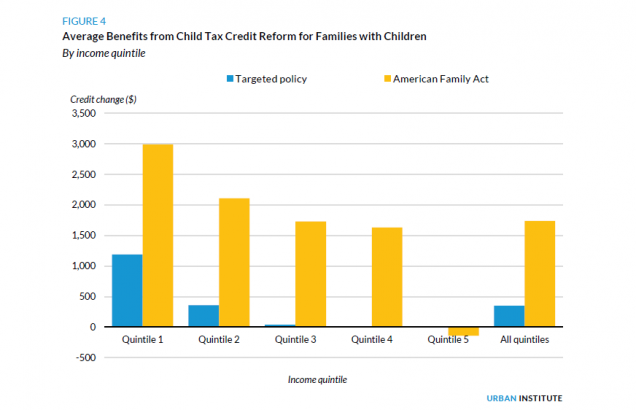
Policy analysts predict the AFA would have powerful and lasting effects on reducing childhood poverty. A report by the Columbia Population Research Center found the AFA would reduce child poverty by 38 percent, and the duel-impact of increasing the credit and eliminating the earnings requirement would move approximately 4 million children out of poverty and 1.6 million out of deep poverty. In 2015 Congress—in a bipartisan action—commissioned a group of experts to produce “a nonpartisan, evidence-based report that would provide its assessment of the most effective means for reducing child poverty by half in the next 10 years.” The report found the most impactful programs involve cash assistance to families, and noted the most effective policy for poverty reduction would be a $2,700 unrestricted child allowance, which the authors report, would alone cut child poverty by a third. Cash subsidies to low income families are also credited for increasing investment in early child development, which links to better learning outcomes and future earning potential. Thus, the AFA implements evidence-based policy for combatting child poverty and promoting broader social and economic benefits for its beneficiaries.
While much of these same benefits could be realized in other progressive policies (such as Universal Basic Income and Universal Childcare), theses government programs require strong Democratic congressional majorities. A closer examination of the political landscape surrounding tax credits and unpaid domestic labor reveals the critical ways the AFA’s form and function can attract Republican support.
To understand the bipartisan potential, we must discuss why many conservatives traditionally support the CTC. Structured fundamentally as a tax credit, the CTC can be framed as a reduction of the federal government. The CTC is more palatable than other anti-poverty initiatives because it bypasses the need for a government program with an expansive bureaucratic administration and a redistributive tax for funding. While this framework is somewhat undermined by the (partially and conditionally) refundable nature, still the CTC addresses the widely supported issue of reducing childhood poverty through an initiative that shrinks the size of the federal government by taking in less tax revenue and not offering a new administrative service. Bennet’s description of the plan demonstrates his awareness of this political tightrope. In the AFA announcement he described it as a tax cut and credit, not a benefit or allowance. When questioned on his word choice he told reporters “I think you could describe it either way.”
Republicans can also frame the CTC and the AFA expansion as pro-family. Conservatives often decry the traditional family structure is under assault and argue programs like the childcare tax credit and proposals like universal childcare structurally nudge stay-at-home parents into the workforce by discounting their unpaid domestic labor. The AFA expansion gives parity in treatment of working and stay-at-home parents. The AFA’s significant credit increase could be framed as offering a simplified and neutrally applied childcare subsidy in lieu of other universal childcare proposals, which commentators on both sides of the debate have described as disadvantaging stay-at-home parents. The Niskanen Center, a center-right think tank, supports expanding the CTC in much the same way the AFA does. It argues the increased credit should unite the left and right through its anti-poverty, pro-family message and impact. It asserts that neutral funds promote individual choice by giving parents the decision-making power to use funds to “help pay for child care for two-parent working families, or help a stay-at-home parent or a grandparent afford necessities such as diapers, transportation, access to the Internet, or educational materials for a child.” The Niskanen Center is not alone on the political right. During his campaign, Donald Trump’s Childcare Plan included a neutrally applied childcare deduction, “offering compensation for the job [stay-at-home parents are] already doing, and allowing them to choose the child care scenario that's in their best interest.” Further demonstrating the bipartisan nature of the fundamental concept and policy, Trump’s December 2017 tax plan expanded the annual CTC credit from $1000-$2000 dollars and modestly lowered the taxable income requirement.
The AFA should pass because it is good data-backed policy, but unfortunately that is not enough. It is the policy’s structure rooted in the tax code, implications supporting stay-at-home-parents, and foundation in a popular bipartisan program that give the AFA an opportunity transcend partisan gridlock and pass through congress.
 Rebecca Gottesdiener anticipates graduating from Boston University School of Law in May 2020.
Rebecca Gottesdiener anticipates graduating from Boston University School of Law in May 2020.
Dying for a Greener Tomorrow: Legalizing Alkaline Hydrolysis
From the first intentional Neanderthal burials to Polish vampire burials and Himalayan sky burials, burial practices have long been and continue to be a large part of our cultural understanding of death and the afterlife. Today’s growing concerns with land and natural resource sustainability as well as global climate change, people look towards ways to slash their carbon footprints upon death. One emerging alternative to traditional cremation is alkaline hydrolysis (also known as resomation and biocremation).
Greater than half of the US population choose conventional modern burials upon death, which includes being filled with embalming fluid, a known carcinogen, being placed into a casket composed of imported tropical hardwoods, and buried inside a concrete-lined grave. In total, conventional burials account for “4.3 million gallons embalming fluid, 827,060 gallons of which is formaldehyde, methanol, benzene, 20 million board feet of hardwoods, including rainforest woods, 1.6 million tons of concrete, 17,000 tons of copper and bronze, 64,500 tons of steel, and [c]askets and vaults leaching iron, copper, lead, zinc, cobalt” yearly in the US. The wood alone could potentially build millions of homes. Moreover, cemetery landscapers often overwater and over fertilize these spaces to keep their green appearance. On top of these environmental effects, America is running out of space for the deceased, particularly urban centers which cannot keep pace with population growth. All of this accounts for 230 pounds of carbon footprint per traditional burial, equivalent to the average American’s three month carbon output.
 Figure 1. Alexandra Harker, through the Berkeley Planning Journal, illustrated the resource intensity of conventional modern burials.
Figure 1. Alexandra Harker, through the Berkeley Planning Journal, illustrated the resource intensity of conventional modern burials.
Traditional flame-based cremations, often thought of as a greener alternative, “uses 92 cubic [meters] of natural gas, releases 0.8 to 5.9 grams of mercury, and is equal to an [500 mile] car trip.” Interestingly enough, mercury dental fillings are one of the greatest concerns attributed to cremation. According to the Cremation Association of North America (CANA), “primary reasons for choosing cremation are; to save money (30%); because it is simpler, less emotional and more convenient (14%); and to save land (13%).” “The most recent figures from 2003 show that the U.S. cremation rate was 28% (700,000 cremations). Based upon increases in acceptance over the past five-year average, the . . . (CANA) has forecast a national cremation rate of 43% by 2025 with over 1.4 million cremations taking place.” Thus, finding a cost-efficient alternative might be the nation’s best bet towards a greener alternative to traditional burial and cremation practices.
Alkaline hydrolysis reduces human remains down to bone fragments, just like the flame-based equivalent, but does so through a water-based dissolution. CANA first defined alkaline hydrolysis in 2010 as “a water-based dissolution process which uses alkaline chemicals, heat, agitation, and pressure to accelerate natural decomposition.” The removal and storage process are similar in both cremation processes, but alkaline hydrolysis provides the added benefit of allowing pacemakers and other implants in place throughout the water-based dissolution unless required by state law. However, the process of reducing the human remains through cremation is distinctly different between the two processes.
“Alkaline hydrolysis uses water, alkaline chemicals, heat, and sometimes pressure and agitation, to accelerate natural decomposition, leaving bone fragments and a neutral liquid called effluent. The decomposition that occurs in alkaline hydrolysis is the same as that which occurs during burial, just sped up dramatically by the chemicals. The effluent is sterile, and contains salts, sugars, amino acids and peptides. There is no tissue and no DNA left after the process completes. This effluent is discharged with all other wastewater, and is a welcome addition to the water systems.”
The process requires unique equipment and training, but the end result is a reduced carbon footprint. After the three to thirteen hour process of moderate heat, pressure, and agitation, the by-products are released in the water as opposed to traditional cremation which releases carbon dioxide and water vapor into the air. The water-soluble by-products include salts and amino acids, which the CANA suggests is “far cleaner than most wastewater.”
“The sterile liquid is released via a drain to the local wastewater treatment authority in accordance with federal, state or provincial, and local laws. The pH of the water is brought up to at least 11 before it is discharged. Because of the contents of the effluent, water treatment authorities generally like having the water come into the system because it helps clean the water as it flows back to the treatment plant. In some cases, the water is diverted and used for fertilizer because of the potassium and sodium content.”
 Figure 2. CANA’s Board of Directors expanded the definition of cremation to include alkaline hydrolysis, mainly because the process and results were similar to traditional flame-based cremation.
Figure 2. CANA’s Board of Directors expanded the definition of cremation to include alkaline hydrolysis, mainly because the process and results were similar to traditional flame-based cremation.
First introduced in 1888 by the farming industry for creating fertilizers from farm animal remains, the process first hit the funerary market in 2011. Today, there are twenty states and three Canadian provinces legalizing the process through legislation. Using U.S. Census Bureau July 2018 data, the twenty states’ population totals over 151.5 million citizens, which accounts for 46.3 percent of the American population. Regardless of the legalization of alkaline hydrolysis, access is today’s constraint. The legalization of the process is the first step towards the wide-spread use of alkaline hydrolysis. Once the processes are available, the price point is in line with traditional cremation services. Anderson-McQueen Funeral Homes lists the transportation, handling, and other fees associated with both cremation processes at approximately $3,000.
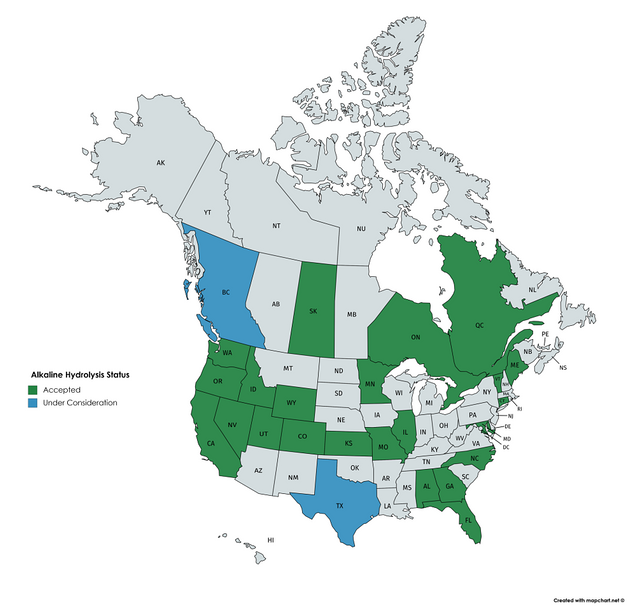 Figure 3. CANA keeps an up-to-date map reflecting alkaline hydrolysis regulatory changes.
Figure 3. CANA keeps an up-to-date map reflecting alkaline hydrolysis regulatory changes.
Once the wide-spread legalization of the process occurs, the public will likely push for greater access to greener cremation practices. It will be interesting to see if and when the process begins in Massachusetts and the remaining 30 states. In any case, the science shows that the massive carbon footprint that traditional burials and cremation services causes.
Tyler Heneghan anticipates graduating from Boston University School of Law in May 2021.
Raise the Age: An Evidence-Based Approach to Juvenile Justice Reform
For a large portion of America’s youth, the 1990s marked the end of juvenile justice. Blinded by fear and captivated by rumors of a “superpredator” uprising, legislatures across the country decided to “Get Tough” on crime. This meant decreasing rehabilitation efforts, increasing punitive repercussions and transferring increasing numbers of youth to adult criminal courts and adult correctional facilities. In effect, “Get Tough” legislation has lowered the legal age of criminal responsibility.
Just under 15,000 individuals under the age of 18 were held in adult jails and state prisons during the 1990s. As crime rates decreased and the “superpredator” hysteria waned, that number decreased sharply, but there are still upwards of 4,000 juveniles being held in adult jails and prisons as of 2018. As well, Emerging Adults, individuals 18–25 years of age, are held responsibility for a disproportionate amount of criminal activity in the United States. Making up only 10% of the total population, Emerging Adults account for almost 30% of criminal arrests and 21% of the adult prison population.
There is little dispute that America’s youth is being held legally responsible for a disturbing amount of crime. The question facing legislatures today is to what extent are these individuals actually culpable for their crimes and whether the adult justice system is the appropriate forum for addressing that culpability.
“Get Tough” Approach
The “Get Tough” movement was largely founded on the premise of the now debunked theory of the “superpredator” promulgated by social and political scientists in the early 1990s. In 1996, Princeton Professor and Criminologist John J. DiIulio Jr. co-authored a book on “the war on crime and drugs”, writing:
[A] new generation of street criminals is upon us -- the youngest, biggest and baddest generation any society has ever known.
America is now home to thickening ranks of juvenile 'superpredators' -- radically impulsive, brutally remorseless youngsters, including ever more preteenage boys, who murder, assault, rape, rob, burglarize, deal deadly drugs, join gun-toting gangs and create serious communal disorders.'
Given that “[the] superpredator is a young juvenile criminal who is so impulsive, so remorseless, that he can kill, rape, maim, without giving it a second thought,” the logical solution to the impending “hordes of depraved teenagers” was imprisonment. Juveniles without a conscience were considered incapable of rehabilitation, and lawmakers were pushed to focus on the punishment and prevention of youth crime.
Scientific & Constitutional Review of “Get Tough”
Support for increased and prolonged incarceration relies heavily on the theory that severe punishment will deter crime. The threat of incarceration is thought to deter the general public from acting reckless or dangerous, while punishment “chastens” the individual to deter future criminal behavior. But both general deterrence and the “chastening effect” fall short of achieving their goals.
General Deterrence
In 2005, the Supreme Court began crediting scientific advances in adolescent neuro-psychology and proscribed the use of capital punishment and mandatory life without parole sentences for juveniles. In Roper v. Simmons, Justice Kennedy opined:
[A] lack of maturity and an underdeveloped sense of responsibility are found in youth more often than in adults and are more understandable among the young. These qualities often result in impetuous and ill-considered actions and decision
Once the diminished culpability of juveniles is recognized, it is evident that the penological justifications for the death penalty apply to them with lesser force than to adults. We have held there are two distinct social purposes served by the death penalty: “ ‘retribution and deterrence of capital crimes by prospective offenders.’ ” Atkins, 536 U. S., at 319 (quoting Gregg v. Georgia, 428 U. S. 153, 183 (1976)
[T]he absence of evidence of deterrent effect is of special concern because the same characteristics that render juveniles less culpable than adults suggest as well that juveniles will be less susceptible to deterrence. In particular, as the plurality observed in Thompson, “[t]he likelihood that the teenage offender has made the kind of cost-benefit analysis that attaches any weight to the possibility of execution is so remote as to be virtually nonexistent.” 487 U. S., at 837.
For general deterrence to be effective, a juvenile must be capable of rationally assessing their actions before they act. As Justice Kennedy noted when he declared juveniles ineligible for the death penalty, juveniles act impulsively and irrationally. Therefore, the threat of prosecution in criminal court is unlikely to deter juveniles from criminal action.
The Chastening Effect
The chastening effect follows the age-old notion that punishment teaches a lesson. The idea that delinquent youth must be taught a lesson was abundant during the “superpredator” scare of the 1990s. The problem is, the evidence does not support that theory. In fact, the evidence suggests the contrary. Youth in the adult criminal justice system are more likely to re-offend upon release.
A Juvenile Recidivism Study in Vermont that compared 16 and 17 year old offenders charged with similar offenses in the juvenile and adult courts. The study found “[t]he three-year recidivism rate for juveniles adjudicated in the Family Division was 25%, compared to a 47% three-year recidivism rate for juveniles convicted in the Criminal Division.” Recidivism can often be attributed to higher levels of isolation and victimization experienced by you in adult correctional facilities, as well as the criminal culture perpetuated by other inmates.
Furthermore, recent studies have found that “the criminal justice system — and the accompanying violence, stress and isolation [ ] that come with being incarcerated — can interfere with brain development in adolescents and children.” A Harvard study on emerging adults concluded:
Higher recidivism rates among emerging adults are not surprising. Justice-involved emerging adults have been victims of violent crime and have experienced emotional and physical trauma at a higher rate than any other population. Exposure to toxic environments such as adult jails and prisons further traumatizes justice involved emerging adults, making them more vulnerable to negative influence, and as a result, increases recidivism among this group. Tailoring the justice system’s response to emerging adults’ developmental needs can reverse this cycle of crime and improve public safety.
“Diminished Culpability”
The Supreme Court has established precedent for amending existing law to meet the “evolving standards of decency,” and decency requires legislatures to re-evaluate the age of criminal responsibility.
The Brain
Much of the research cited by the Supreme Court back in the early 2000s found that those traits the Court ruled “diminished culpability” are present even in late adolescence (age 17, 18, and 19). However, as of January 11, 2019, 17 states still prosecute adolescence age 17, 18, and 19 as adults. An additional 5 states allow the prosecution of juveniles as young as 16 in adult court.
Recent advances in developmental brain science has shown that the human brain is still developing well in to their 20s. The well established consensus in the scientific community is that the brain functioning of a juvenile is not comparable to that of an adults until at least age 25. Particularly relevant to diminished culpability is the continuing development of the prefrontal lobe. The prefrontal lobe is responsible for executive functions such as risk assessment, planning, self-evaluation, goal-setting, and the regulation of our emotions.
Emerging Adults
Psychologist Jeffrey Arnett coined the term “Emerging Adult” in 2000. In the context of criminal justice, emerging adults refers to individuals having attained 18 years of age up to 25 years of age. This age group should be especially important to legislatures because emerging adults have higher rates of incarceration and recidivism. A national study of 30 states revealed that approximately 78% percent of emerging adults released in 2005 were re-arrested within 3 years. Whereas approximately 73% percent of those 25 to 29 and 63% percent of those 40 and older were rearrested within 3 years of release. The study found the pattern held true 5 years after release, and under 30% of those new arrests were violent.
Higher recidivism rates among emerging adults can be attributed Justice-involved emerging adults have been victims of violent crime and have experienced emotional and physical trauma at a higher rate than any other population. Exposure to toxic environments such as adult jails and prisons further traumatizes justiceinvolved emerging adults, making them more vulnerable to negative influence, and as a result, increases recidivism among this group. Tailoring the justice system’s response to emerging adults’ developmental needs can reverse this cycle of crime and improve public safety. Conversely, when emerging adults are provided with age-appropriate programing, the recidivism rate drops dramatically.
Moreover, a large portion of offenders, even violent offenders, age-out of crime. On average, property crimes peak at age 16 and violent crimes at age 17. According to a Justice Policy Institute report,
The evidence is clear that most young people will desist from criminal behavior without intensive justice-system involvement. By better addressing the unique needs and behavior of young adults, justice systems can develop responses that limit the risk youth pose to themselves and others during this transitory life stage.
Raise the Age
The “Raise the Age” campaign advocates for legislation that raises the maximum age of juvenile jurisdiction. Raising that age allows more developmentally underdeveloped individuals to be tried in a juvenile or family court. These courts are considerably more focused on education and rehabilitation that adult criminal courts.
In 2013, Massachusetts raised the age from 17 to 18, and juvenile crime has declined by 34%. Also on the decline in Massachusetts is the number of youth in juvenile facilities. Massachusetts success in raising the age can be attributed to “improving community-based responses and using cost-effective and developmentally appropriate approaches.”
Most states now include 17-year-olds in juvenile jurisdiction, but only one state – Vermont – has raised the age above 18 in conformance with advances in developmental studies of the brain.
Modern science tells us that emerging adults take more risks, have less self-control and are less culpable of their crimes. An evidence-based approach to legislation would demand a re-evaluation of emerging adults in the criminal justice system and the enactment of age-appropriate reforms.
 Melissa Mayfield anticipates graduating from Boston University School of Law in May 2021.
Melissa Mayfield anticipates graduating from Boston University School of Law in May 2021.
Sanctuaries With Guns? Turning The Rule Of Law Upside Down; by Delegate David Toscano (D-Charlottesville)
The Tazewell County, Virginia, Board of Supervisors recently jumped aboard the fast-moving “Second Amendment sanctuaries” train. In doing so, they embraced positions fundamentally at odds with state and federal constitutional law. Passing resolutions opposing certain laws or protesting governmental action is perfectly consistent with our traditions as a democracy, and no one should oppose the rights of citizens and their representatives to speak their minds. But Tazewell, and a number of other localities across Virginia, want to do much more. As Eric Young, an attorney and the county’s Administrator, put it, “our position is that Article I, Section 13, of the Constitution of Virginia reserves the right to ‘order’ militia to the localities; counties, not the state, determine what types of arms may be carried in their territory and by whom. So, we are ‘ordering’ the militia by making sure everyone can own a weapon." Other counties are announcing different schemes if gun safety laws are enacted: for example, the Culpeper County sheriff pledged to deputize “thousands of citizens” so they can own firearms.
Conservatives have railed for years against so-called “sanctuary jurisdictions,” criticizing localities that refuse to cooperate with federal immigration policies they deem heartless and ineffective. In the past year, however, some conservative lawmakers have taken a page from the progressive playbook, employing sanctuary imagery in opposition to gun safety legislation they deem to be an unconstitutional restriction of their rights under the Second Amendment.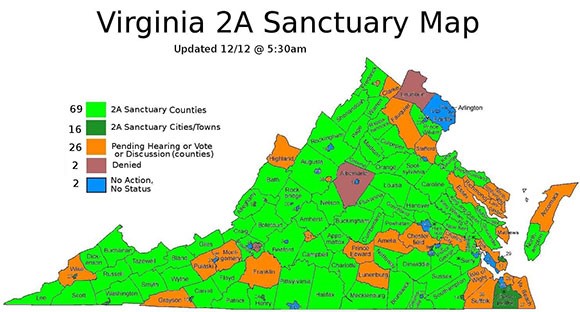
The two approaches are classic cases of false equivalency. Jurisdictions that proclaim themselves sanctuaries for immigrants do not seek to violate the law; they simply refuse to engage local law enforcement in supporting actions that are federal responsibilities. They do not block the law, but simply insist that it should be enforced by those who have the responsibility to do so. For some proponents of so-called gun sanctuaries, however, the goal is to prevent enforcement of state law that the jurisdiction (not a court) deems unconstitutional.
After Democrats won majorities in both chambers of the Virginia General Assembly, fears of stricter gun regulations have inspired a rise in Second Amendment sanctuary activity in Virginia. Sanctuary efforts are driven mainly by the Virginia Citizens Defense League, a gun rights group to the right of the NRA. My office’s analysis of recent news accounts indicates that before November 5, just one county had passed a resolution; since the election, at least 80 localities (counties, cities, or towns) have passed some form of sanctuary resolution, and as many as 34 more are considering their adoption.
A REBELLION EMERGES
Second Amendment sanctuaries exploded onto the national scene in early 2019 after newly-elected Democratic Gov. J.B. Pritzker pledged to pass gun safety measures in Illinois. Within months, 64 of the state’s 102 counties passed sanctuary resolutions. After New Mexico expanded background checks in 2019, 30 of 33 counties declared themselves Second Amendment sanctuaries. Similar actions have either been taken or are under consideration in Colorado, Oregon, Washington state, and now Virginia.
In some cases, these resolutions simply register an objection to any infringement on gun owners’ rights. But some Virginia localities have gone further, indicating that they will not enforce state law that they deem unconstitutional. Some proponents have even resurrected words like “nullification” and “interposition,” terms first used extensively by Southern secessionists prior to the Civil War, and more recently during the “massive resistance” to federal laws requiring desegregation in the 1960s. They argue that constitutional officers in Virginia, such as Commonwealth’s Attorneys and Sheriffs, have discretion not to enforce laws that they consider “unconstitutional.” In Virginia, there has always existed some debate about the independence of these officers, but, while they are creations of the Constitution, their duties are nonetheless "prescribed by general law or special act.” In short, sheriffs may be “constitutional officers,” but they are not “constitutional interpreters.”
FLASHPOINTS IN THE CULTURE WARS
The emergence of these sanctuaries demonstrates a growing rift in our nation. For residents in many rural areas of our country, guns are viewed as part of their way of life, one some fear that they will lose due to national and state changes. Most gun owners are law-abiding citizens, and any effort to limit anyone's access to firearms is perceived as a direct attack on many things that they hold dear. During the Obama years, the manufacture and purchase of firearms increased in dramatic numbers in part due to unfounded fears that the government would try to take away guns. Voting to declare themselves “sanctuaries” is a way they can reassert some control over events that they feel are putting them at risk. For these communities, it matters little that reasonable gun safety proposals have largely passed constitutional muster, or that most proponents of these measures have no intention of taking anyone’s guns away unless it can be shown, in a court of law, that they are a danger to themselves or others.
At the same time, the general public is increasingly supportive of certain gun safety measures. An April 2018 poll found that 85 percent of registered voters support laws that would "allow the police to take guns away from people who have been found by a judge to be a danger to themselves or others" (71 percent "strongly supported"). These measures, called Emergency Risk Protection Orders (ERPO), or “red flag” laws, create judicial procedures by which persons with serious mental health challenges deemed a threat to themselves or others can have their weapons removed until their situation is resolved; courts can be engaged to protect the rights of the accused. And a March 2019 Quinnipiac poll reported that 93 percent of American voters support a bill that would require “background checks for all gun buyers.”
The energy behind support of gun measures like "red flag" laws is generated by concern for mass shootings, which are statistically rare but dramatic in their public impact, and the increasing numbers of gun-related suicides, which impact families and communities in quiet but devastating ways. On the latter front, there is a certain irony that some communities which have embraced Second Amendment sanctuary status also have higher gun suicide rates than other communities in their state. In Colorado, for example, nine of the 10 counties with the highest suicide rate over the past 10 years have declared themselves “Second Amendment sanctuaries,” many after the state passed an ERPO law in 2019. Of the 24 Colorado sanctuary counties for which suicide data is available, 22 (or 92 percent) had firearm suicide rates above the state average. Similarly, in Virginia, 36 of the 51 localities that have adopted a resolution to date and for which firearm suicide data is available have rates higher than the state median.
Recent polling in Virginia tells us that citizens of the Commonwealth are in step with the national trends documented above: Roanoke College’s Institute for Public Opinion Research recently released polling results which show that 84 percent of respondents favor universal background checks, and 74 percent support allowing a family member to seek an ERPO from a court. Yet in the very same pool of respondents, 47 percent believe it is more important to protect the right to own guns than to control gun ownership. The only way to make the math add up is to recognize that some people who strongly support Second Amendment rights may also support at least some reasonable gun safety measures—an approach the “sanctuary” advocates would never adopt. But even former Supreme Court Justice Antonin Scalia might have had problems with some of the arguments being advanced by proponents of sanctuaries. “Like most rights,” he wrote in District of Columbia et. al. v. Heller, “the right secured by the Second Amendment is not unlimited. From Blackstone through the 19th-century cases, commentators and courts routinely explained that the right was not a right to keep and carry any weapon whatsoever in any manner whatsoever and for whatever purpose." In short, rights under the Second Amendment have never been absolute. And under both the national and state Constitutions, our courts are tasked with determining the constitutionality of laws—not local sheriffs.
HOME RULE VS. DILLON RULE
Proponents of Second Amendment sanctuaries have another problem in Virginia; the Commonwealth is what we call a “Dillon Rule” state. This means that if a power is not specifically permitted to a locality, state law rules. Progressives have been especially critical of Dillon Rule arguments in years past, believing that they have prevented localities from enacting policies—from local minimum wage ordinances to gun prohibitions—that seek to go further from state law. They have rarely been concerned that more conservative localities, if granted greater “home rule,” might enact policies, such as environmental regulations or building codes, that are more lax than state law. The Second Amendment sanctuary rebellion may prompt some to reexamine their views about how much additional power should be granted to localities.
The Virginia state legislature will soon consider several major gun safety measures, and opponents will likely strongly resist; as one county supervisor has said, “[W]e need to show them a crowd like they have never seen. They need to be afraid and they should be afraid.” Legislators should always be attuned to any unintended consequences of the laws that they pass; that is one reason why we have a deliberative process before bills are passed. But to leave the determination of whether to enforce duly-passed laws totally in the hands of sheriffs and local officials with discretionary power to determine their constitutionality is to turn the rule of law upside down, and is a direct attack on republican government and the Constitution itself.
David Toscano has represented the 57th district in the Virginia House of Delegates since 2006, and from 20011-2019 Del. Toscano served as the House's Democratic Leader. His forthcoming book is titled, In the Room at the Time: Politics, Personalities, and Policies in Virginia and the Nation.
A modified version of this opinion piece appeared on Slate.com.


